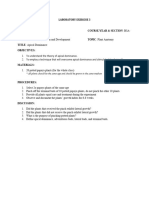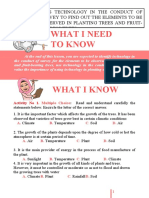0 ratings0% found this document useful (0 votes)
10 viewsLABORATORY EXERCISE #3 Transplanting
LABORATORY EXERCISE #3 Transplanting
Uploaded by
Esther Suan-Lancita1. The document provides instructions for Laboratory Exercise #3 on transplanting seedlings. Students will demonstrate proper removal of plants from seedbeds and recognize the importance of minimizing root disturbance during transplanting.
2. Materials needed include vegetable seedlings, pots, growing media, garden tools, and gloves. Procedures include supporting the soil ball, tapping roots free from the seedbed, and promptly potting the seedling to reduce exposure.
3. A discussion section asks why transplanting is necessary, why seedlings are not started in large pots, and why root trimming should be minimized.
Copyright:
© All Rights Reserved
Available Formats
Download as DOCX, PDF, TXT or read online from Scribd
LABORATORY EXERCISE #3 Transplanting
LABORATORY EXERCISE #3 Transplanting
Uploaded by
Esther Suan-Lancita0 ratings0% found this document useful (0 votes)
10 views1 page1. The document provides instructions for Laboratory Exercise #3 on transplanting seedlings. Students will demonstrate proper removal of plants from seedbeds and recognize the importance of minimizing root disturbance during transplanting.
2. Materials needed include vegetable seedlings, pots, growing media, garden tools, and gloves. Procedures include supporting the soil ball, tapping roots free from the seedbed, and promptly potting the seedling to reduce exposure.
3. A discussion section asks why transplanting is necessary, why seedlings are not started in large pots, and why root trimming should be minimized.
Original Description:
Agriculture
Copyright
© © All Rights Reserved
Available Formats
DOCX, PDF, TXT or read online from Scribd
Share this document
Did you find this document useful?
Is this content inappropriate?
1. The document provides instructions for Laboratory Exercise #3 on transplanting seedlings. Students will demonstrate proper removal of plants from seedbeds and recognize the importance of minimizing root disturbance during transplanting.
2. Materials needed include vegetable seedlings, pots, growing media, garden tools, and gloves. Procedures include supporting the soil ball, tapping roots free from the seedbed, and promptly potting the seedling to reduce exposure.
3. A discussion section asks why transplanting is necessary, why seedlings are not started in large pots, and why root trimming should be minimized.
Copyright:
© All Rights Reserved
Available Formats
Download as DOCX, PDF, TXT or read online from Scribd
Download as docx, pdf, or txt
0 ratings0% found this document useful (0 votes)
10 views1 pageLABORATORY EXERCISE #3 Transplanting
LABORATORY EXERCISE #3 Transplanting
Uploaded by
Esther Suan-Lancita1. The document provides instructions for Laboratory Exercise #3 on transplanting seedlings. Students will demonstrate proper removal of plants from seedbeds and recognize the importance of minimizing root disturbance during transplanting.
2. Materials needed include vegetable seedlings, pots, growing media, garden tools, and gloves. Procedures include supporting the soil ball, tapping roots free from the seedbed, and promptly potting the seedling to reduce exposure.
3. A discussion section asks why transplanting is necessary, why seedlings are not started in large pots, and why root trimming should be minimized.
Copyright:
© All Rights Reserved
Available Formats
Download as DOCX, PDF, TXT or read online from Scribd
Download as docx, pdf, or txt
You are on page 1of 1
LABORATORY EXERCISE #3
NAME: COURSE/YEAR & SECTION:
TOPIC: Plant Propagation: Transplanting SUBJECT: Principles and Practices of Plant
Breeding, Propagation and
Nursery Management
TITLE: Transplanting of Seedlings
OBJECTIVES:
1. To demonstrate the proper method of removing plants from seedbed for transplanting
2. To recognize the importance of not disturbing the roots in order to reduce plant shock that occurs
during transplanting
MATERIALS:
1. Vegetable seedlings performed in Lab# 2
2. Pots
3. Growing media
4. Garden stake or trowel
5. Gloves and boots
PROCEDURES:
1. The same groupings formed in Lab #2. Each member should perform in transplanting the
seedlings.
2. Place one hand on the soil surface to support the ball of soil. Spread your finger around the plant
stem.
3. With the use of garden stake, tap the edge of the seedling firmly but gently.
4. Allow the plant with the ball of soil to slip out of the seed bed.
5. Place the removed plant ball upright in your free hand and transplant the seedling to the prepared
hole in a larger pot. Do not allow roots to be exposed to the air for an extended period.
6. Document your performed activity to support your lab report.
7. Hand in your handwritten laboratory report 3 days after the activity.
DISCUSSION:
1. Why is it necessary to transplant plants?
2. Why aren’t plants started out in large pots or the ground from the very beginning?
3. Why should root trimming be kept at a minimum?
4. Do you think that different size pots would be more difficult to transport? (comment)
5. Does the age of the plant being transplanted matter?
You might also like
- Lesson Plan Life Cycle of PlantsDocument4 pagesLesson Plan Life Cycle of PlantsLily FernandezNo ratings yet
- Plant Tropism LabDocument21 pagesPlant Tropism LabNik Naqiuddin Faris0% (1)
- 10-Horticulture-Q2m3-Without Key MessageDocument14 pages10-Horticulture-Q2m3-Without Key MessageHENJEL PERALESNo ratings yet
- AFA Agri-Crop 9 Q2W3Document18 pagesAFA Agri-Crop 9 Q2W3Alvin DuaneNo ratings yet
- Afa Agri-Crop 9 q2w3Document37 pagesAfa Agri-Crop 9 q2w3JMGNo ratings yet
- Laboratory Exercise #7 MicropropagationDocument1 pageLaboratory Exercise #7 MicropropagationESTHER LANCITANo ratings yet
- Tle 6 Activity Sheets q1w7 1Document5 pagesTle 6 Activity Sheets q1w7 1jocelyn f. junioNo ratings yet
- Topik 2 Eksplorasi Konsep 2 BHS Inggris - GracellaDocument9 pagesTopik 2 Eksplorasi Konsep 2 BHS Inggris - Gracellapeserta.11392No ratings yet
- Lesson Plan in TLE - Agriculture Q1Document5 pagesLesson Plan in TLE - Agriculture Q1gania carandangNo ratings yet
- Germination - : 3 Through 5 GradeDocument7 pagesGermination - : 3 Through 5 GradeMathumalarNo ratings yet
- Vegetative PropagationDocument5 pagesVegetative Propagationvenomwolf484No ratings yet
- Q2 Week4 Day2Document5 pagesQ2 Week4 Day2LAARNI DE LA SANTANo ratings yet
- PHBIOSC 201: Pharmaceutical Botany With Taxonomy Laboratory: Learning Activity 3: Plant PropagationDocument2 pagesPHBIOSC 201: Pharmaceutical Botany With Taxonomy Laboratory: Learning Activity 3: Plant PropagationClint Jhun TabugocNo ratings yet
- Q2 Week3 Day2Document5 pagesQ2 Week3 Day2LAARNI DE LA SANTANo ratings yet
- All Lesson PlansDocument20 pagesAll Lesson Plansapi-398084037No ratings yet
- Grade 11 Q2 Module 6 Week 6Document11 pagesGrade 11 Q2 Module 6 Week 6Shiela MaeNo ratings yet
- TLE 6 - Week5Document6 pagesTLE 6 - Week5Luis SalengaNo ratings yet
- LMHRT241Document61 pagesLMHRT241Alpha ChickNNo ratings yet
- Module 1 Pant NurseryDocument19 pagesModule 1 Pant NurseryRaizaNo ratings yet
- Lesson-2 Germinating-Seeds Grade-3 en FINAL v2Document6 pagesLesson-2 Germinating-Seeds Grade-3 en FINAL v2Adrian RamroopNo ratings yet
- Asexual Propagation by Miming Momaming PDFDocument6 pagesAsexual Propagation by Miming Momaming PDFLebron DoggiNo ratings yet
- Technology and Livelihood Education: Quarter 2 - Module 4 Week 4Document9 pagesTechnology and Livelihood Education: Quarter 2 - Module 4 Week 4Michelle Kirsten DELA Fuente0% (1)
- Q3 Tle Week 5Document15 pagesQ3 Tle Week 5Filipinas Sta MariaNo ratings yet
- Laboratory Exercise 4 Apical DominanceDocument1 pageLaboratory Exercise 4 Apical DominanceEsther Suan-LancitaNo ratings yet
- New Format Agro 301Document8 pagesNew Format Agro 301Angel MantalabaNo ratings yet
- Final - Wlas 3RD Quarter - Week.8 10 1Document12 pagesFinal - Wlas 3RD Quarter - Week.8 10 1wilmermelindocozo2No ratings yet
- G-6-HELE-Module-2nd 2121-2022Document8 pagesG-6-HELE-Module-2nd 2121-2022Annie AlbertoNo ratings yet
- Laboratory Manual: HRT 241 Production Technology For Vegetables and Spices Laboratory (For Private Circulation Only)Document61 pagesLaboratory Manual: HRT 241 Production Technology For Vegetables and Spices Laboratory (For Private Circulation Only)Ch Dheeraj RaoNo ratings yet
- Laboratory Exercise #6 GraftageDocument2 pagesLaboratory Exercise #6 GraftageESTHER LANCITANo ratings yet
- TLE6 CapSLET Agri Q1 W6Document13 pagesTLE6 CapSLET Agri Q1 W6ALRAEIS ABDULHAMIDNo ratings yet
- Lesson 1234 Sy 2021 2022Document28 pagesLesson 1234 Sy 2021 2022Badtuan Asliya E.No ratings yet
- Tle-Acp: Quarter 2 - Module 4 Interpret Plans and DrawingsDocument18 pagesTle-Acp: Quarter 2 - Module 4 Interpret Plans and DrawingsLester John Catapang100% (1)
- Module 2 - Unit 1 - Lesson 1&2Document40 pagesModule 2 - Unit 1 - Lesson 1&2Angel AlvarezNo ratings yet
- Tropisms Lab - 2019 PDFDocument3 pagesTropisms Lab - 2019 PDFaslNo ratings yet
- TLE6-CapSLET AgriQ1 W2Document12 pagesTLE6-CapSLET AgriQ1 W2Gia AlvarezNo ratings yet
- What I Need To Know: Lesson 1Document8 pagesWhat I Need To Know: Lesson 1Mayaman UsmanNo ratings yet
- 1.lesson Notes - Plants and The EnvironmentDocument3 pages1.lesson Notes - Plants and The EnvironmentUzma Waqas/Education/HONo ratings yet
- Seed GerminationDocument6 pagesSeed GerminationAdrian GonzalesNo ratings yet
- Inbound 1223126232Document13 pagesInbound 1223126232canoydexeeNo ratings yet
- Cot 3 Q4 GR.4Document5 pagesCot 3 Q4 GR.4CJ ConcubiertaNo ratings yet
- Stored Seed EnergyDocument7 pagesStored Seed EnergyaljeceralorenaNo ratings yet
- Q3 WK2 Las Tle6 - AgricultureDocument7 pagesQ3 WK2 Las Tle6 - AgricultureRubelyn Olila DalisayNo ratings yet
- B8 Sci WK3Document3 pagesB8 Sci WK3Kofi PaaNo ratings yet
- Plant Lesson PlanDocument7 pagesPlant Lesson Planapi-363984140No ratings yet
- 3rd Moodule 5 22 23 PDFDocument16 pages3rd Moodule 5 22 23 PDFQueen StephNo ratings yet
- 5E Lesson PlanDocument4 pages5E Lesson PlanElla Angelie BaticanNo ratings yet
- Board Plan: Session 2023-24 Class-V Subject - ScienceDocument7 pagesBoard Plan: Session 2023-24 Class-V Subject - SciencebhartiNo ratings yet
- Demonstration Lesson PlanDocument6 pagesDemonstration Lesson PlanXerxes PhemenineNo ratings yet
- Y4 - Module 3Document19 pagesY4 - Module 3fernandojaylordngoho2797No ratings yet
- TLE G6 Q1 Module 3Document9 pagesTLE G6 Q1 Module 3Cindy EsperanzateNo ratings yet
- Agriculture and Fishery: Crop ProductionDocument31 pagesAgriculture and Fishery: Crop ProductionPepito Del CastilloNo ratings yet
- Lesson 4 Weve Be An GrowingDocument11 pagesLesson 4 Weve Be An GrowingchocklingamNo ratings yet
- Acp NC 2 ActivitiesDocument5 pagesAcp NC 2 ActivitiesTuesday Escabarte100% (1)
- GR6 Tle Q1 W5 D1-D5Document10 pagesGR6 Tle Q1 W5 D1-D5Erdell BaronNo ratings yet
- Hansons SlideDocument12 pagesHansons SlideKrissy2424No ratings yet
- Grade-4 SADHANA WB KEY Chapter -7Document5 pagesGrade-4 SADHANA WB KEY Chapter -7smparida2018No ratings yet
- Laboratory Exercise #4 CuttageDocument2 pagesLaboratory Exercise #4 CuttageESTHER LANCITANo ratings yet
- The Effect On The Growth of Mung Beans (Vigna Radiata) by Where It Is Grown - (RESEARCH LAB REPORT)Document21 pagesThe Effect On The Growth of Mung Beans (Vigna Radiata) by Where It Is Grown - (RESEARCH LAB REPORT)Baymax EatShowNo ratings yet
- Introduction To Agriculture: Esther S.lancitaDocument25 pagesIntroduction To Agriculture: Esther S.lancitaEsther Suan-Lancita100% (2)
- Republic of The Philippines 60: Sultan Kudarat State University College of Teacher EducationDocument8 pagesRepublic of The Philippines 60: Sultan Kudarat State University College of Teacher EducationEsther Suan-LancitaNo ratings yet
- Agriculture and Agronomy OutlineDocument14 pagesAgriculture and Agronomy OutlineEsther Suan-LancitaNo ratings yet
- Registered Crop VarietiesDocument33 pagesRegistered Crop VarietiesEsther Suan-LancitaNo ratings yet
- Lecture 2 Levels of Biological OrganizationDocument15 pagesLecture 2 Levels of Biological OrganizationEsther Suan-LancitaNo ratings yet
- Understanding SelfDocument80 pagesUnderstanding SelfEsther Suan-LancitaNo ratings yet
- Sultan Kudarat State University College of Teacher EducationDocument7 pagesSultan Kudarat State University College of Teacher EducationEsther Suan-LancitaNo ratings yet
- Nsic FruitDocument135 pagesNsic FruitEsther Suan-LancitaNo ratings yet
- Registered Crop Varieties: Yield (T/ha) 100-Seed Weight (G) DS WS DS WS 0.86Document21 pagesRegistered Crop Varieties: Yield (T/ha) 100-Seed Weight (G) DS WS DS WS 0.86Esther Suan-LancitaNo ratings yet
- Plant CellDocument80 pagesPlant CellEsther Suan-LancitaNo ratings yet
- Lecture 4 Sexual Reproduction in PlantsDocument40 pagesLecture 4 Sexual Reproduction in PlantsEsther Suan-LancitaNo ratings yet
- Lecture 2 Levels of Biological OrganizationDocument14 pagesLecture 2 Levels of Biological OrganizationEsther Suan-LancitaNo ratings yet
- Nsic FiberDocument3 pagesNsic FiberEsther Suan-LancitaNo ratings yet
- Lecture 6Document6 pagesLecture 6Esther Suan-LancitaNo ratings yet
- Lecture 3Document5 pagesLecture 3Esther Suan-LancitaNo ratings yet
- Introduction and History of Soil ScienceDocument20 pagesIntroduction and History of Soil ScienceEsther Suan-LancitaNo ratings yet
- Unit. Soil Organic MatterDocument9 pagesUnit. Soil Organic MatterEsther Suan-LancitaNo ratings yet
- Unit Iv. Soil Colloids and Soil Fractions: Permanent ChargesDocument5 pagesUnit Iv. Soil Colloids and Soil Fractions: Permanent ChargesEsther Suan-LancitaNo ratings yet
- Soil Biology and Fertility Restoration RDocument38 pagesSoil Biology and Fertility Restoration REsther Suan-LancitaNo ratings yet
- Laboratory High School Third Quarterly Exam Science and TechnologyDocument3 pagesLaboratory High School Third Quarterly Exam Science and TechnologyEsther Suan-LancitaNo ratings yet















































































